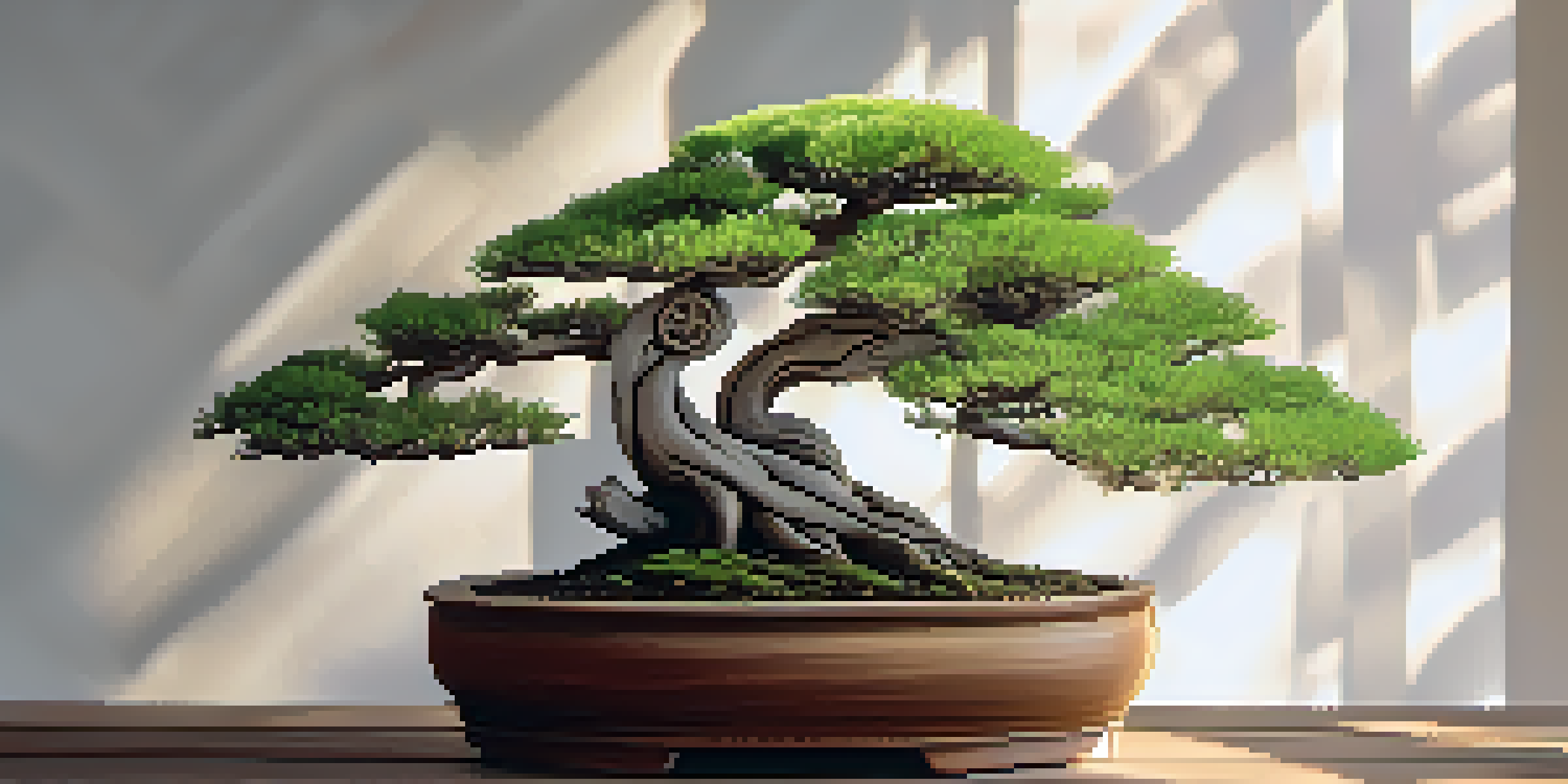Bonsai Aesthetics: Understanding Balance and Harmony

The Art of Bonsai: A Brief Introduction
Bonsai is more than just a miniature tree; it's an art form that reflects nature's beauty in a smaller scale. Originating in China and later popularized in Japan, bonsai encapsulates a philosophy of patience and meticulous care. Each tree tells a unique story, inviting observers to appreciate the intricate relationship between nature and artistry.
The creation of a bonsai is a metaphor for life itself, a balance of patience and perseverance.
To truly understand bonsai, one must recognize that it's not solely about growing a small tree. It's about cultivating a living piece of art that embodies the balance and harmony found in nature. This delicate practice combines horticultural skill with aesthetic principles, making it a fascinating journey for both beginners and seasoned enthusiasts.
As you delve deeper into bonsai, you'll discover that every twist and turn of the branches serves a purpose. The aesthetics of bonsai encourage mindfulness, urging caretakers to observe and respond to the tree's needs, further enhancing the connection between the artist and the art.
Understanding Balance in Bonsai Design
Balance in bonsai refers to the visual equilibrium that makes a tree pleasing to the eye. This concept is vital, as it guides the placement of branches, leaves, and even the pot. Achieving balance requires careful thought about the tree's shape and size, ensuring that no part overpowers another.

An example of balance can be seen in the classic 'informal upright' style, where the trunk leans slightly to one side. This lean creates a dynamic tension, as it appears to reach for the light while maintaining stability. The placement of branches around the trunk enhances this balance, drawing the viewer's eye naturally around the tree.
Bonsai is an Art Form
Bonsai transcends being a mere miniature tree; it represents a unique blend of nature's beauty and artistic expression.
By focusing on balance, bonsai artists convey a sense of tranquility and harmony. A well-balanced bonsai not only captivates the observer but also illustrates the interconnectedness of all elements in nature, reminding us of the natural world's delicate equilibrium.
The Role of Harmony in Bonsai Aesthetics
Harmony in bonsai goes hand in hand with balance, creating a cohesive visual experience. It encompasses the relationship between the tree and its container, as well as the interplay of color, texture, and form. When harmony is achieved, the tree feels like a natural part of its environment, rather than a separate entity.
To create a bonsai is to create a landscape in miniature, where every detail matters and harmony reigns.
For instance, choosing a pot that complements the tree's style can enhance its overall aesthetic. A round pot might work beautifully with an informal upright tree, while a rectangular pot can lend a more structured feel to a formal style. The right pot not only supports the tree but also contributes to the harmonious look of the entire arrangement.
In essence, harmony is about creating a unified composition that resonates with viewers. It encourages a sense of peace and balance, allowing observers to connect emotionally with the bonsai, experiencing a moment of tranquility in their busy lives.
The Influence of Nature on Bonsai Aesthetics
Bonsai aesthetics are deeply rooted in the observation of nature. The way trees grow in the wild, shaped by elements like wind and sunlight, serves as a guide for bonsai artists. Drawing inspiration from these natural forms helps create a tree that feels authentic and true to life.
Artists often replicate the asymmetrical shapes found in nature, as they tend to be more visually appealing. A tree that mimics the way it would grow in its native habitat can evoke a sense of realism. By embracing the imperfections found in nature, bonsai artists create a deeper connection with their work.
Balance is Key in Bonsai Design
Achieving balance in bonsai involves careful consideration of the tree's shape and elements, creating visual harmony.
This influence of nature extends beyond just the form of the tree. Seasonal changes, such as the vibrant colors of autumn leaves or the stark beauty of winter branches, inspire artists to appreciate the beauty in all stages of growth. This connection to nature enhances the overall aesthetic, reminding us of the ever-changing cycles of life.
Techniques for Achieving Balance and Harmony
Achieving balance and harmony in bonsai requires a combination of techniques and keen observation. Pruning is one of the most critical aspects, as it shapes the tree's structure and encourages growth in desired areas. By selectively removing branches, artists can maintain balance and create a harmonious silhouette.
Wiring is another essential technique used to guide branches into the desired position. By gently wrapping wire around branches, artists can manipulate their shape over time. This allows for a more dynamic design while ensuring the tree maintains its balance as it grows.
Moreover, understanding the tree's growth patterns is crucial. Each species has its unique characteristics, so knowing how to work with the tree's natural tendencies will lead to a more harmonious result. By applying these techniques thoughtfully, bonsai artists can create stunning works of art that embody both balance and harmony.
Cultural Significance of Bonsai Balance and Harmony
The principles of balance and harmony in bonsai extend beyond aesthetics; they hold cultural significance as well. In many cultures, bonsai symbolizes peace, patience, and contemplation. The time and effort invested in caring for a bonsai tree resonate with the virtues of dedication and mindfulness.
For instance, in Japanese culture, bonsai is often linked to Zen philosophy, which emphasizes living in the moment and appreciating simplicity. The meticulous care required in bonsai cultivation mirrors the Zen practice of mindfulness, encouraging practitioners to focus on the present.
Bonsai Reflects Personal Philosophy
For bonsai artists, the cultivation process reflects their personal values and philosophies, fostering a deep connection to their art.
Through this cultural lens, the aesthetics of bonsai become a form of meditation, inviting individuals to reflect on their lives. By nurturing a bonsai, one not only cultivates a beautiful tree but also fosters a deeper understanding of balance and harmony within themselves.
Bonsai as a Reflection of Personal Philosophy
For many bonsai artists, their trees serve as a reflection of their personal philosophy. The choices made in shaping and caring for a bonsai often mirror the artist's values and beliefs. Whether it's striving for perfection or embracing imperfection, each tree tells a story unique to its caretaker.
This intimate relationship fosters a sense of ownership and responsibility. As artists nurture their trees, they also cultivate patience and resilience, learning to accept the natural pace of growth. This journey of personal development makes bonsai cultivation a meaningful, lifelong pursuit.

Moreover, sharing bonsai with others creates a sense of community. Whether through exhibitions or casual meet-ups, artists exchange ideas and philosophies, enriching each other's understanding of balance and harmony. In this way, bonsai becomes a collaborative art form that extends beyond individual experiences.